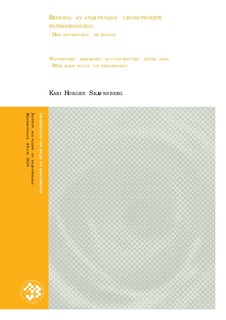| dc.description.abstract | I denne studien har tre filterbedanlegg med horisontal strømning under overflaten
blitt undersøkt. Filterbedanleggene, anlegg A, B og C, er dimensjonert for mottak
av avløpsvann fra henholdsvis 2 husstander, 23 husstander og 2 hytter, 3 husstander
og kafédrift.
Under feltarbeidet høsten 2008 ble filtermateriale tatt ut som ni søyler fra anlegg
A og C, og tolv søyler fra anlegg B. Ved uttak av filtermateriale hadde anleggene
eksistert i henholdsvis fem, fire og ni år. Søylene ble inndelt i 10 cm lange
deler som tilsammen utgjorde 247 prøver. Det ble foretatt analyser av P, Ca, Mg,
Fe og Al fra filtermaterialet. Ledningsevne, pH, total P, total N og TOC ble målt i
vannprøver fra innløpet og utløpet. Vannprøver fra anleggenes totale driftstid ble
analysert.
Levetiden til et filterbedanlegg er forventet å være 10-15 år. I følge beregninger
basert på gjennomsnittlige fosforverdier funnet anriket i anleggene, vil anlegg A
og B ha en levetid på omlag 14 år. Den beregnede levetiden til anlegg C er fem
ganger høyere enn maksimal forventet levetid. Dette viser, i tillegg til lav renseprosent
for fosfor, at anlegg C ikke fungerer optimalt.
De undersøkte anleggene viser en tendens til økende anrikning av fosfor mot
bunnen. Basert på gjennomsnittlig utregning av fosfor i anleggene er det høyest
anrikning ved innløpet i alle anleggene. Det er ikke påvist nedtransportering av
små partikler av kalk, noe som viser at homogeniteten i filtermaterialet ikke har
endret seg i driftsperioden.
Gjennomsnittlig maksimal dybde ved uttak av filtermaterialet var omlag
80 cm. For å kunne måle den faktiske mengden fosfor som er anriket i anleggene
må filtermateriale ned til den teoretiske bunnen av anleggene, som skal være ved
120 cm, analyseres.
Forventet renseprosent for fosfor i filterbedanlegg er høyere enn 90 %. Maksimal
tillatt utslippskonsentrasjon for fosfor er 1 mg 1-1 i anlegg A og B, og 0,8 mg 1-1 i anlegg C. For anlegg A stiger fosforkonsentrasjonen i utløpet i femte driftsår,
samtidig som høy renseprosent opprettholdes. Dette kan tyde på at det blir tilført
høyere andel fosfor enn tidligere. I anlegg B er fosforkonsentrasjonene under
maksimalt tillatt utslipp og jevnt høy renseprosent er opprettholdt, mens i anlegg C stiger utløpskonsentrasjonen av fosfor etter sjette driftsår til 3,5 mg 1-1. Renseprosenten
for anlegg C synker til omlag 65 % etter at anlegget har eksistert i ti
år.
For å få anleggene til å fungere optimalt er det viktig med kontinuerlig driftsoppfølging
og vedlikehold. Tekniske enheter må kontrolleres, forfilter rakes, i
tillegg til at prøvetaking med påfølgende analyser må gjennomføres. Three filter beds with horizontal subsurface flow are investigated in this study. The
filter bed plants A, B and C are dimensioned for reception of wastewater from 2
households, 23 households and 2 cabins, 3 households and a café, respectively.
During the fieldwork in autumn 2008, samples of the filter media was collected
from each plant. These samples consisted of nine columns from plant A and C
and twelve from plant B. Analysis of the content of P, Ca, Mg, Fe and Al were
performed. Conducitivty, pH, Total P, Total N and TOC were measured from water
samples from the inlet and the outlet.
By autumn 2008 plants A, B and C had existed for five, four and nine years,
respectively. A filter bed has an expected lifespan from 10 to 15 years. Based on
the analyzed data the lifespan of plant A and B are estimated to approximately 14
years. The estimated lifespan of plant C is five times higher than the maximum
expected lifespan. This, in addition to low efficiency of phosphorous removal,
leads to the conclusion that plant C is not working optimally.
All three plants show increasing fortification of phosphorous at increasing
depths. The mean fortification of phosphorous is largest at the inlet of all three
plants. The filter media is still quite homogeneous since the measured distribution
of particles is almost uniform.
The efficiency of phosphorous removal in filter beds is expected to lie above
90 %. The maximum allowed outlet concentration of phosphorpus is 1 mg 1-1 for
plants A and B and 0,8 mg 1-1 for plant C. Plant A shows a quite rapid increase in
outlet concentrations of phosphorous in its fifth operating year. Still, the efficiency
of phosphorus removal is kept at a high level. This may be due to increasing concentrations
of phosphorus at the inlet. In plant B the phosphorus concentrations at
the outlet are below the limit values and the efficiency of phosphorus removal are
kept at a high level. In its sixth operating year, plant C shows an outlet concentration
of phosphorus of 3,5 mg 1-1. After ten years of operation the efficiency of
phosphorus removal for plant C reaches approximately 65 %. | en_US |
